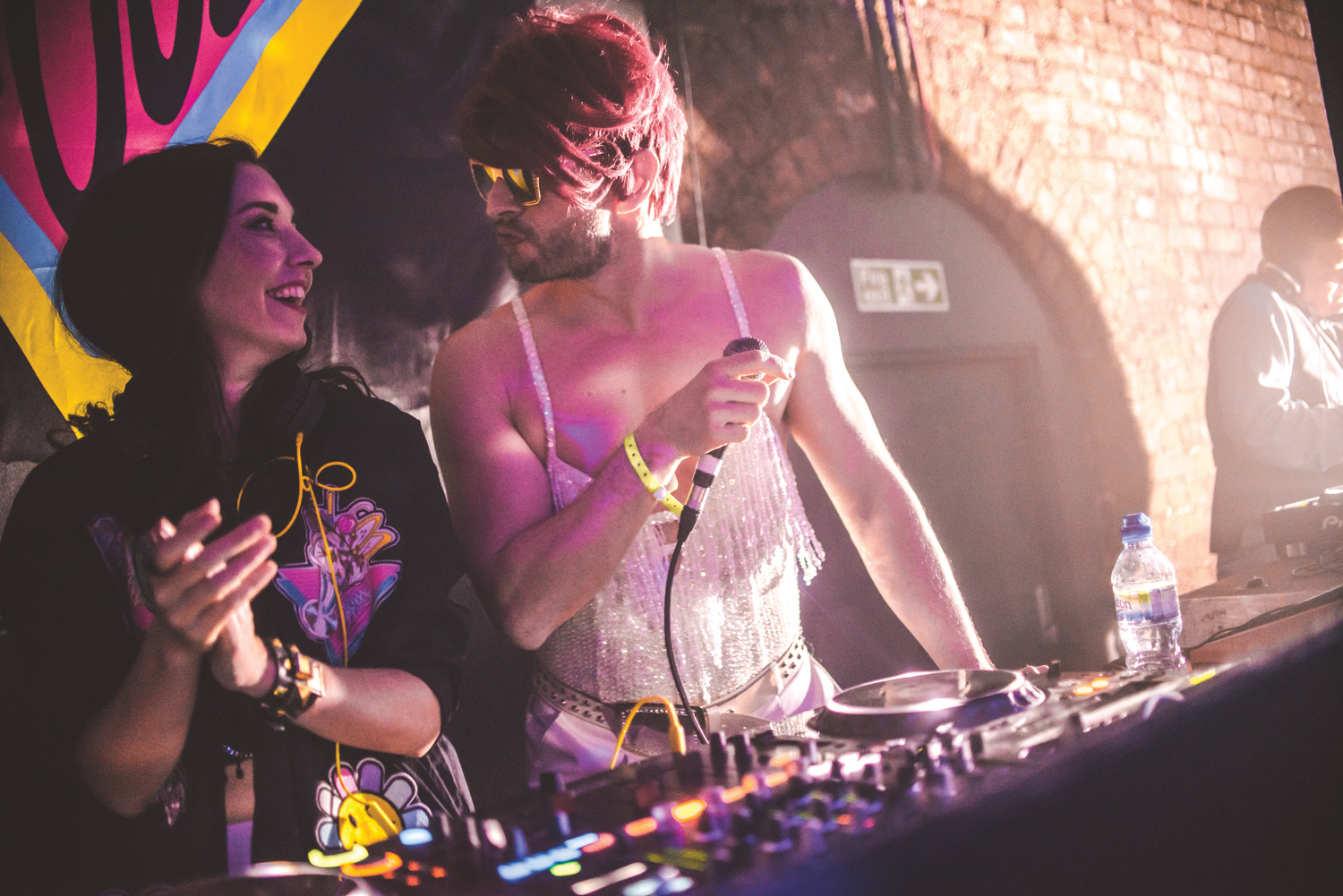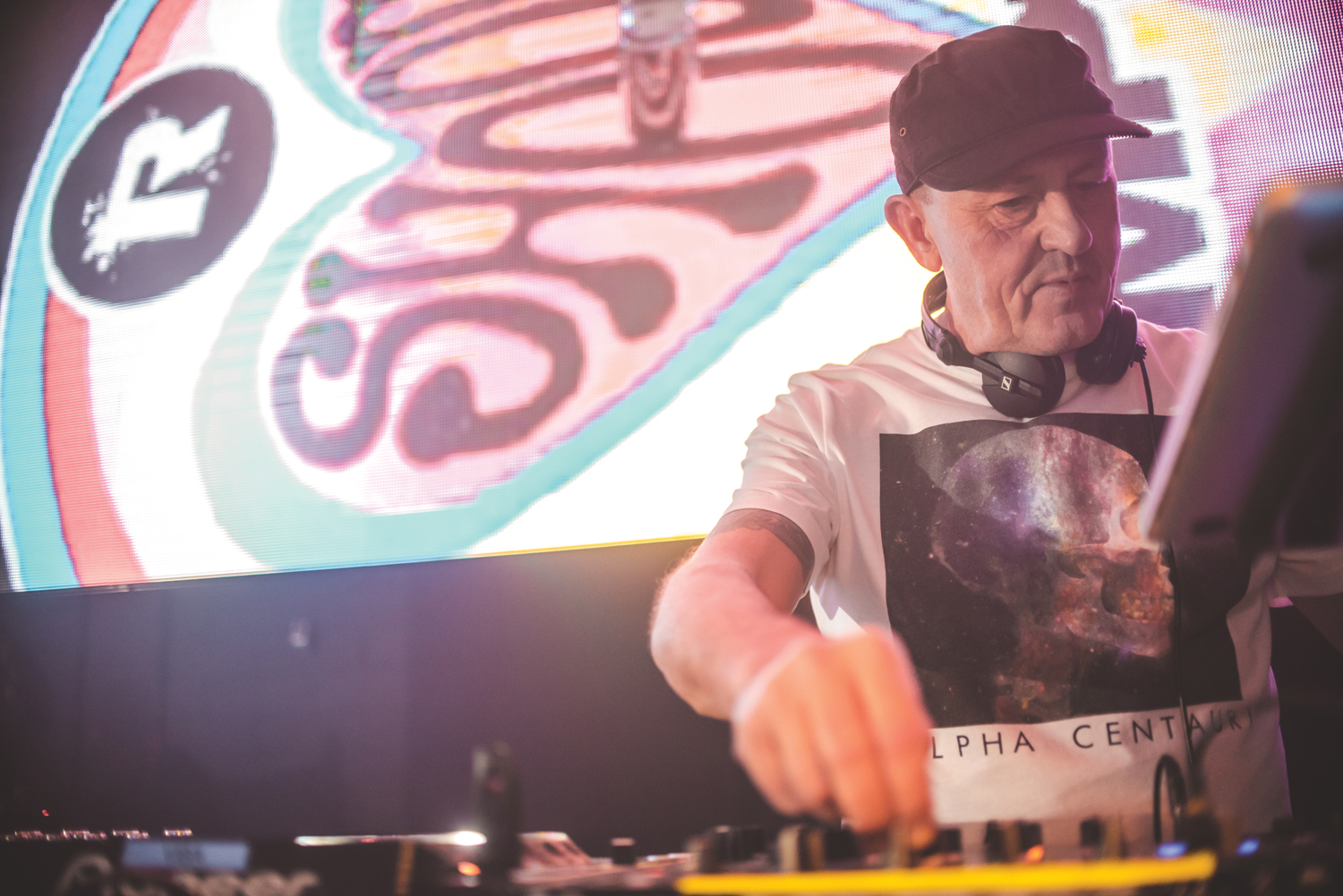
Shoom's spirit of positivity, happiness, togetherness lives on
The UK’s original house club is 30
“Fucking hell mate, it’s been years!” a man in baggy dungarees fastened only on one side, yellow T-shirt and furry Kangol bucket hat roars as he embraces an old friend. Variants of this conversation play out countless times throughout the night. It’s 30 years since the launch of Danny Rampling’s seminal club night, Shoom. Tonight’s celebration, held at Pulse/Bankside Vaults on London’s South Bank, was the closest thing you’ll ever get to going back to the late 80s in a time capsule: Women in large Umbro sweatshirts gyrate with men in Reebok Classics and fur-hooded green parkas. The crowd twists, turns and bobs to the 4/4 beats, thumping bassline and squelchy acid synths that consume the electric atmosphere.
The whole scene, playing out to a backdrop of visuals featuring footage from iconic acid house events, feels a bit special. After all, the musical and cultural journey of Shoom – from 300 people in the basement of a Southwark fitness centre to being instrumental in the wholesale transformation of youth culture – deserves to be celebrated accordingly. For many people, UK clubbing culture began in that dusty, mirrored basement 30 years ago.
We all know how that came about, right? In 1987, Rampling, along with Paul Oakenfold, Johnny Walker and Nicky Holloway, experienced a now-famed spiritual awakening in Ibiza. The clubs, music and spirit of the place (oh, and a new drug called ecstasy… apparently) was too intoxifying to leave behind. So on their return home they launched parties, Shoom being one of them, ushered in the acid house era, arguably brought club culture to the UK (some outside London take issue with this narrative) and shook up the very fabric of British society in the process. “All the influences that we’d experienced in Ibiza we had to share,” Rampling told Mixmag. “From a very early stage we all knew that it was going to be huge. Just everything about it.”

The 30th birthday party is sold out, but not oversold; people still have room to dance. A great deal of effort has gone into the production of the night, from a laser show to a ‘VR space’ hosted by Mutator VR which immerses the punters in surreal, trippy artwork that morphs and evolves in response to their dancing.
X-Press 2, Bushwacka!, Tony Humphries and Danny himself provide the soundtrack to the eccentric madness, keeping the dancefloors jumping and the acid-drenched tempo going until the bitter end. Walking through the bouncing room you can immediately tell that the crowd is almost exclusively made up of the original punters by the complete absence of any phones. “There isn’t actually any film footage from Shoom,” Rampling says. “People have it recorded in their minds and in their hearts, but there’s no video footage.”
“This used to happen a lot back in the day,” one geezer wearing a sky-blue Sergio Tacchini tracksuit and who looks like he’s walked straight off the set of The Business indicates, when the tunes momentarily cut out. “Especially in the fields.” How long has he been coming to Shoom? “Thirty years; I’ve been involved since the beginning,” he says, simultaneously throwing his arms aloft as Humphries drops Raze’s ‘Break 4 Love’ to roars from the crowd.
Despite the fact that original session-heads quite possibly on their first little one since the mid 90s make up the majority of the clientele, there are some fresh faces around too. “I found out about this event on an app and me and my girlfriend bought tickets,” 18-year-old Ste, who’s here to see Leftfield (now just Neil Barnes), explains. “A lot of people here are older than me but it’s quite a good vibe; I couldn’t imagine trouble.” What about the music? “It’s a lot different, but it’s all house and techno at the end of the day which I can relate to.”
For many people we speak to, the night is a one-off chance to relive old memories. “I’m a librarian who used to go clubbing at Shoom when I was much younger,” a jumpsuit-wearing fifty-something named Nina shouts over the crowd, which is singing Joe Smooth’s ‘Promised Land’ in unison. “Now I go out very seldom, but every so often there’s a night like this that catches my imagination so I come along – and I love it.” She adds: “People of all ages are still mesmerised by this sort of thing. Look around: the original values of respect and unity are still alive.”

Kalimo, a 29-year-old who puts on disco-house nights in London, had never heard of Shoom before, but came to see Tony Humphries. “From a person who goes out to different clubs every weekend and loves music, the energy here has been really positive,” he says. “Everybody is just happy; I don’t know if that’s because of nostalgia or the music – or both.”
By all accounts, one of the original values that Shoom was founded on was unity. “Danny had a profound effect on me the first time I went,” says Michael, a 59-year-old retired escort. “While he was doing his set he got down off the stage, out of the heavens, amongst the crowd. Here was a superstar DJ and he was high-fiving everyone and saying hi. I’ve never forgotten that.”
The idea of breaking down social barriers is still alive at some club nights, but for others it’s lost amid VIP areas and Instagram culture. “I’m not a fan of the sectioned off VIP area; never have been,” Rampling says. “I think it’s poncey and divides people in clubs. The ethos of the club scene that we helped to create was not about dividing people: It was about uniting people. Yes, time moves on, but bottle service in supposedly ‘underground’ clubs is… it’s not an underground club any more, is it? It’s a very commercial enterprise that makes a lot of money.”
So what made Shoom so special in the first place? “The mixture of people, the collective spirit,” he says. “The whole ethos was about positivity, happiness, togetherness – that was the spirit and the essence. There was magic in that room, as there is in all the great nightclubs.”
It doesn’t happen often, but some subcultures transcend generations and have enduring appeal. Music scenes, fashion trends and drug crazes usually transform as people move on to sample the latest cultural offerings. But it seems that, as long as we have dark rooms, towering soundsystems and repetitive beats, the values of this particular club night will live on indefinitely.


